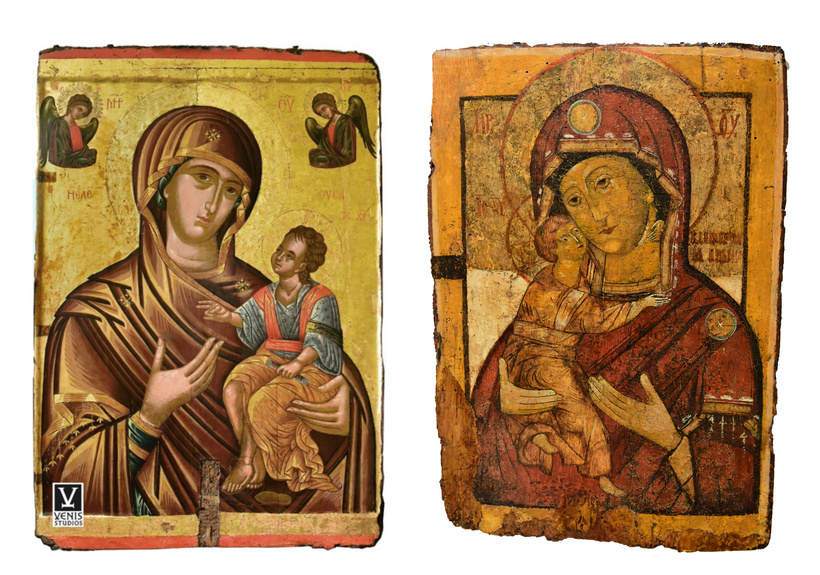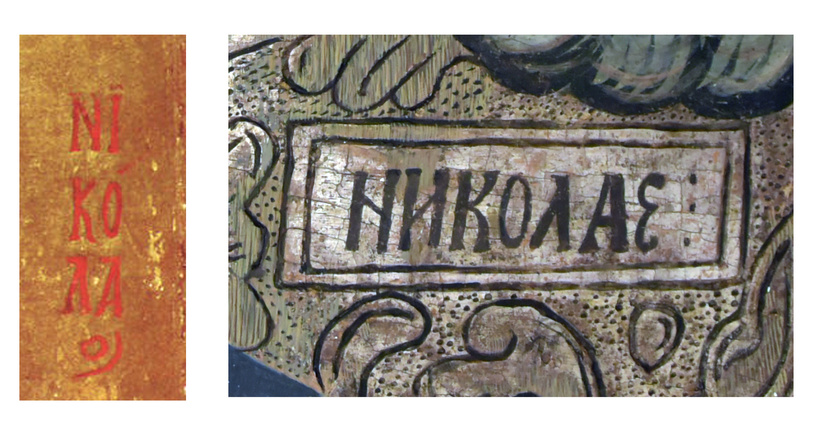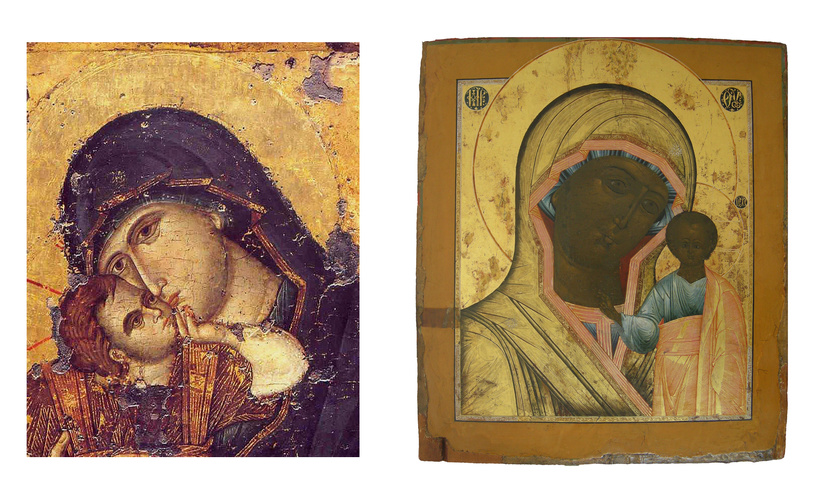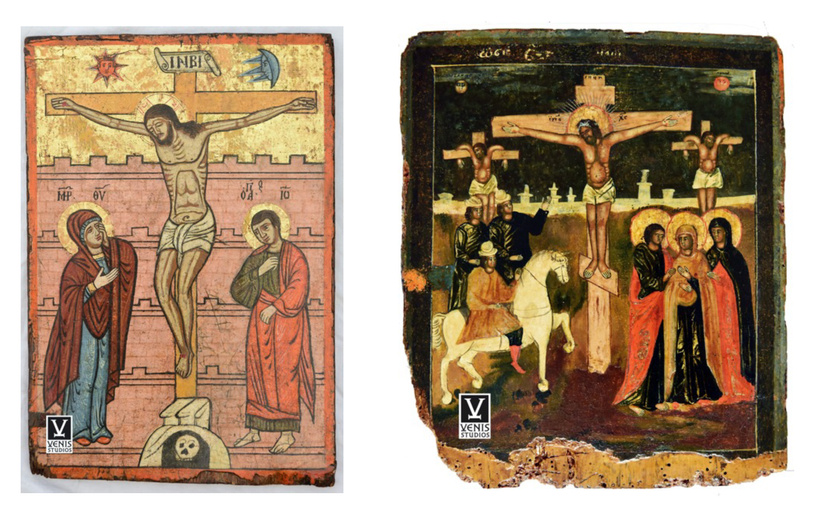
©VENIS STUDIOS
Iconography stands as one of the most profound and enduring forms of artistic expression within Eastern Orthodox Christianity. Among the vast tapestry of religious art, Greek and Russian icons hold a special place, revered not only for their spiritual significance but also for their rich historical and cultural heritage. These sacred images, often referred to as “windows into heaven,” serve as visual embodiments of faith, bridging the earthly and the divine.
Despite their shared origins in Byzantine tradition, Greek and Russian icons have evolved distinct characteristics that reflect the unique religious, cultural, and artistic influences of their respective regions. This article delves into the subtle yet significant differences between these two iconic traditions, exploring how each has developed its own identity while remaining deeply connected to the broader Orthodox Christian world.
Through a comparative lens, we will examine the historical contexts, stylistic features, and theological underpinnings that distinguish Greek and Russian iconography. In doing so, we hope to illuminate the ways in which these sacred images continue to inspire devotion and artistic admiration across generations and cultures.

©VENIS STUDIOS
The Divergence Between Greek and Russian Iconography
The tradition of creating Russian icons began in Kievan Rus’ following the adoption of Orthodox Christianity in 988 AD. Initially, these icons adhered strictly to the artistic models and formulas sanctified by Byzantine art, guided from the capital of Constantinople. This early style is often referred to as “Greek Icons.” The influence of Russian iconography extends beyond Russia to Bulgaria, Ukraine, Romania, and across the Slavic world. As such, the term “Russian icons” is often used to describe any Slavic type of iconography.
Although Russian and Greek icons share a common historical lineage and may appear similar to the untrained eye, there are distinct differences between these two branches of Orthodox Christian art.
The creative and personal traditions characteristic of Western European religious art were largely absent in Russia prior to the 17th century. It was during this period that Russian iconography began to be influenced by the religious paintings and engravings of both Protestant and Catholic Europe.
1. Liturgical and Devotional Differences
Both Russian and Greek icons are central to worship and prayer. However, Russian icons often emphasise individual devotion and piety, while Greek icons are more communal and liturgical, focusing on the role of the Church and its traditions in worship.
2. Historical and Cultural Origins
Greek icons emerged in the Byzantine Empire, reflecting the artistic traditions of the Greco-Roman world, with influences from the Eastern Mediterranean and the Middle East. Russian icons, developed in medieval Russia, incorporate Byzantine elements while also displaying distinct local characteristics.

©VENIS STUDIOS
3. Language and Labeling
Russian icons are typically labelled in Church Slavonic, a very old Cyrillic language, whereas Greek icons are labelled in Greek.
4. Symbolism and Imagery
Greek icons often employ simpler, more symbolic imagery with less emphasis on naturalistic representation, focusing on the spiritual rather than the material.

©VENIS STUDIOS
5. Stylistic Characteristics
Greek icons often feature a more refined and elongated style, characterised by serene facial expressions, intricate patterns, and gold backgrounds. In contrast, Russian icons, particularly from the medieval period, showcase bolder colours, a greater emphasis on narrative elements, and regional stylistic variations.
6. Approach to Color and Linework
Greek iconographers are known for their skill in mixing colours, using light or different shades of the base colour to highlight prominent features such as shoulders, knees, and hips. Russian icon painters, however, place more emphasis on linework, with colour playing a more subordinate role.
7. Use of Colour
Greek masters favour radiant and bright colours that often contrast sharply. Russian iconographers, on the other hand, typically use more restrained and subdued colours, often painting in pastel tones, with some icons executed almost entirely in a single colour.
8. Application of Ground Color
The ground colour of large fields in Greek religious icons is applied opaquely. In Russian icons, however, the ground colour is often transparent, allowing the white priming to show through.
9. Painting Techniques
One of the key differences lies in the painting techniques. Russian icons often feature more intricate and detailed brushwork, with a greater emphasis on realism.
10. Regional Variations
Early 13th-century images from Novgorod exhibit voluminous forms, strict expressions, and vibrant colours applied in broad, soft strokes, with a palette dominated by the red of cinnabar. In contrast, icons from Rostov and Iaroslav have heavier forms, deeper colours, and more rhythmic compositions, expressing a distinctly heroic spirit.
11. Gilding Techniques
Since the 19th century, Russian icons have employed impressive polishing gilding techniques, often with engraved geometrical patterns on the gilded surfaces. At times, parts of the gilding are coloured, giving the impression of enamel.
12. Framing
Russian icons are often framed with a thick painted border in ochre or dark green, whereas Greek icons typically have only a very thin line, usually in red, orange, or rarely black.
13. Rarity and Production
The production of Russian icons is much greater than that of Greek icons, making Greek icons rarer and less common.

©VENIS STUDIOS
Bridging the Sacred and the Artistic
The study of Greek and Russian iconography offers a window into the spiritual and cultural histories of Orthodox Christianity. While rooted in a shared Byzantine tradition, these two schools of iconography diverged over centuries, shaped by distinct regional, theological, and artistic influences. Greek icons, with their emphasis on symbolic simplicity and communal liturgy, contrast with the more narrative-driven and individually focused Russian icons, each reflecting the spiritual needs and artistic expressions of their respective societies.
Understanding these differences not only deepens our appreciation of the icons as religious artefacts but also as historical documents that narrate the evolution of Eastern Christian art. Both Greek and Russian icons continue to inspire reverence and awe, serving as timeless bridges between the divine and the human, the past and the present. As we explore these sacred images, we are reminded of the profound role that art plays in shaping and reflecting the spiritual landscape of a culture.
I want to learn more:
by Venizelos G. Gavrilakis
Edited Athina Gkouma
About the author:
Venizelos G. Gavrilakis, a renowned expert in the art conservation and restoration of Byzantine and post-Byzantine icons, historical oil paintings, and Ottoman-era artwork, has been working as a senior expert conservator and restorer since 1994. He has worked with various institutions and has been involved in international conservation meetings and conferences. Gavrilakis is the president of the art conservation and restoration company VENIS STUDIOS, based in Istanbul, Turkey, and has collaborated with galleries, antique dealers, and private collectors.
-
Articles: World Art News articles
Our related articles

